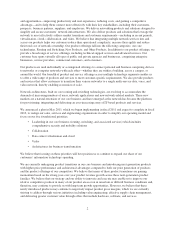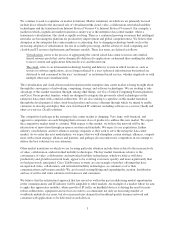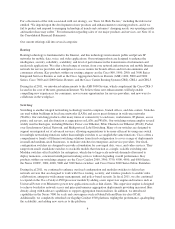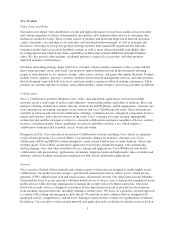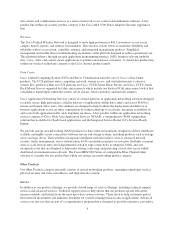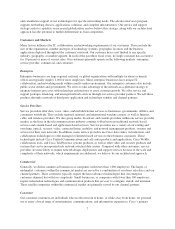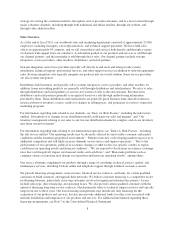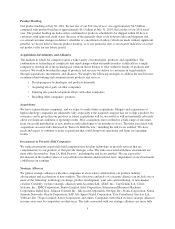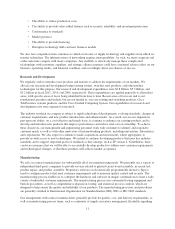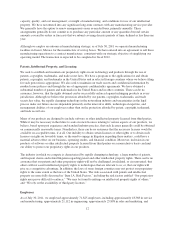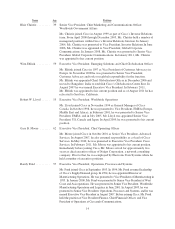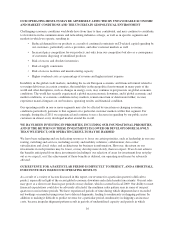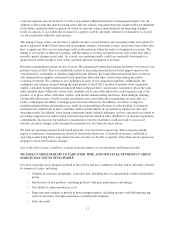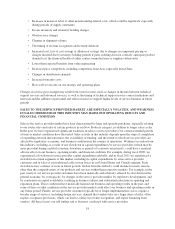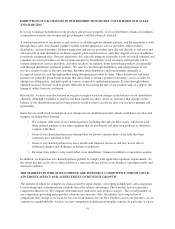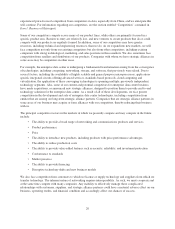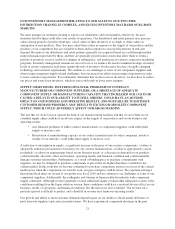Cisco 2011 Annual Report Download - page 19
Download and view the complete annual report
Please find page 19 of the 2011 Cisco annual report below. You can navigate through the pages in the report by either clicking on the pages listed below, or by using the keyword search tool below to find specific information within the annual report.• The ability to reduce production costs
• The ability to provide value-added features such as security, reliability, and investment protection
• Conformance to standards
• Market presence
• The ability to provide financing
• Disruptive technology shifts and new business models
We also face competition from customers to which we license or supply technology and suppliers from which we
transfer technology. The inherent nature of networking requires interoperability. As such, we must cooperate and
at the same time compete with many companies. Any inability to effectively manage these complicated
relationships with customers, suppliers, and strategic alliance partners could have a material adverse effect on our
business, operating results, and financial condition, and accordingly affect our chances of success.
Research and Development
We regularly seek to introduce new products and features to address the requirements of our markets. We
allocate our research and development budget among routers, switches, new products, and other product
technologies for this purpose. Our research and development expenditures were $5.8 billion, $5.3 billion, and
$5.2 billion in fiscal 2011, 2010, and 2009, respectively. These expenditures are applied generally to all product
areas, with specific areas of focus being identified from time to time. Recent areas of focus are tied to our
foundational priorities and include, but are not limited to, our core routing and switching products, Cisco
TelePresence systems products, and the Cisco Unified Computing System. Our expenditures for research and
development costs were expensed as incurred.
The industry in which we compete is subject to rapid technological developments, evolving standards, changes in
customer requirements, and new product introductions and enhancements. As a result, our success depends in
part upon our ability, on a cost-effective and timely basis, to continue to enhance our existing products and to
develop and introduce new products that improve performance and reduce total cost of ownership. To achieve
these objectives, our management and engineering personnel work with customers to identify and respond to
customer needs, as well as with other innovators of internetworking products, including universities, laboratories,
and corporations. We also expect to continue to make acquisitions and investments, where appropriate, to
provide us with access to new technologies. We intend to continue developing products that meet key industry
standards and to support important protocol standards as they emerge, such as IP version 6. Nonetheless, there
can be no assurance that we will be able to successfully develop products to address new customer requirements
and technological changes, or that those products will achieve market acceptance.
Manufacturing
We rely on contract manufacturers for substantially all of our manufacturing needs. We presently use a variety of
independent third-party companies to provide services related to printed-circuit board assembly, in-circuit test,
product repair, and product assembly. Proprietary software on electronically programmable memory chips is
used to configure products that meet customer requirements and to maintain quality control and security. The
manufacturing process enables us to configure the hardware and software in unique combinations to meet a wide
variety of individual customer requirements. The manufacturing process uses automated testing equipment and
burn-in procedures, as well as comprehensive inspection, testing, and statistical process controls, which are
designed to help ensure the quality and reliability of our products. The manufacturing processes and procedures
are generally certified to International Organization for Standardization (ISO) 9001 or ISO 9003 standards.
Our arrangements with contract manufacturers generally provide for quality, cost, and delivery requirements, as
well as manufacturing process terms, such as continuity of supply; inventory management; flexibility regarding
11



